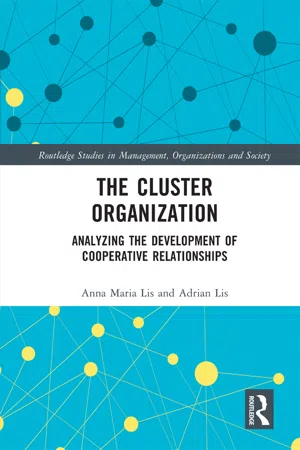
The Cluster Organization
Analyzing the Development of Cooperative Relationships
- 272 pages
- English
- ePUB (mobile friendly)
- Available on iOS & Android
The Cluster Organization
Analyzing the Development of Cooperative Relationships
About This Book
Cluster organizations are becoming more and more popular, both in developing and developed countries. Considering the development of cluster policy and the related dynamic growth of cluster initiatives in the world, the lack of sufficient knowledge on the development of cooperation in cluster organizations inhibits their development and, in many cases, causes their complete disintegration.
The book provides new important elements to the current system of knowledge, filling in cognitive and research gaps in the scientific literature on problems related to cooperation in cluster organizations. The most valuable features for the reader concern the epistemological, methodological, and application aspects. The new element includes a theoretical concept, which refers to the trajectory of development of cooperative relationships in cluster organizations that facilitates the understanding and explanation of mechanisms responsible for cooperation in such organizations.
The concept also has great practical advantages, especially for people implementing the idea of "clustering": coordinators, facilitators, and members of cluster organizations as well as politicians and public authorities are responsible for shaping and implementing the cluster policy. It will be of value to researchers, academics, and students in fields with an interest in organizational studies, management of innovation and technology, strategic management, industrial economics, and economic geography.
Frequently asked questions
1 Introduction
Contextual Background and Motivation
The Research Problem and Aim of the Book
Structure and Contents
2 Theoretical Foundations of Clusters and Cluster Organizations
The Concept of a Cluster and a Cluster Organization
Theories on the Establishment and Development of Industrial Clusters
Table of contents
- Cover
- Half Title
- Series Page
- Title Page
- Copyright Page
- Contents
- List of Figures and Tables
- 1 Introduction
- 2 Theoretical Foundations of Clusters and Cluster Organizations
- 3 Theoretical Foundations of Cooperation in Cluster Organizations
- 4 Application of Grounded Theory and the Abduction Approach to the Research of Cluster Organizations
- 5 Development of Cooperation in Cluster Organizations: Results of Empirical Research
- 6 Application of the Generated Concept to Selected Cluster Organizations in Europe
- 7 Conclusions
- Index